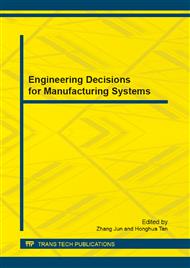p.495
p.502
p.508
p.514
p.520
p.526
p.533
p.538
p.543
The Nonparametric Confidence Interval for the Process Capability Index C*pmk
Abstract:
The process capability index which is a generalization of is defined by the use of the idea of Chan et al. [ for asymmetric tolerance. In this paper, we proposed a Jackknife confidence interval for and compare its coverage probability with the other three Efron and Tibshiranis [ bootstrap interval estimate techniques. The simulation results show that the Jackknife method has higher chance of reaching the nominal confidence coefficient for all cases considered in this paper. Therefore this method is recommended for used. One numerical example to demonstrate the construction of confidence interval for the process capability index is also given in this paper.
Info:
Periodical:
Pages:
520-525
Citation:
Online since:
September 2013
Authors:
Keywords:
Price:
Сopyright:
© 2013 Trans Tech Publications Ltd. All Rights Reserved
Share:
Citation:


